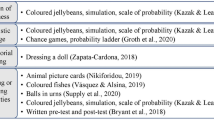Abstract
The purpose of this study is to establish levels from an inductive proof to an algebraic demonstration in lower secondary school mathematics. I propose that we can establish six levels of proof in lower secondary school mathematics as steps from an inductive proof to an algebraic demonstration on the basis of three axes (contents of proof, representation of proof, and students' thinking). To reach this conclusion, I firstly examine the meaning of ‘demonstration in lower secondary school mathematics’ and ‘proof in lower secondary school mathematics’, and show the relationships between them. Secondly, I set out four basic levels of proof, as seen from two aspects (contents and representation of proof). Thirdly, I subdivide them into six levels from the third aspect of students' thinking. Finally, I illustrate my discussion with a 7th grader's activities.
Similar content being viewed by others
REFERENCES
Balacheff, N.: 1987, 'Processus de preuve et situations de validation', Educational Studies in Mathematics 18, 147-146.
Balacheff, N.: 1988a, 'Aspects of Proof in pupils' practice of school mathematics', in D. Pimm (ed.), Mathematics, teachers and children, Hodder & Stoughton, London, pp. 216-230.
Balacheff, N.: 1988b, 'Thèse: Une étude des processus de preuve en mathématique chez les élèves de collège', Université Joseph Fourier, Grenoble.
Blum, W. and Kirsh, A.: 1991, 'Preformal proving: examples and reflections', Educational Studies in Mathematics 22, 183-203.
Braconne, A. and Dionne, J.J.: 1987, 'Secondary school students' and teachers' understanding of demonstration in geometry', in J.C. Bergeron, N. Herscovics and C. Kieran (eds.), Proceedings of the 11th International Conference for the Psychology of Mathematics Education, Vol. III, Université de Montréal, Montréal, pp. 109-116.
De Villiers, M.: 1991, 'Pupils' needs for conviction and explanation within the context of geometry', in F. Furinghetti (ed.), Proceedings of the 15th International Conference for the Psychology of Mathematics Education, Vol. III, Dipartimento di Mathematica dell'Università di Genova, Assisi, pp. 255-262.
Elementary and secondary education bureau of Monbusho: 1985, 'Kyouikukatei jissijyoukyou nikansuru sougouteki chousahoukokusyo: chuugakkou suugaku (General survey on the accomplished status of curriculum: junior high school mathematics) (MESC-3-8517)', Monbusho (Ministry of Education, Science, Sports and Culture), Tokyo.
Fawcett, H.P.: 1938, The nature of proof: a description and evaluation of certain procedures used in a senior high school to develop an understanding of the nature of proof (The National Council of Teachers of Mathematics, The Thirteenth Yearbook), AMS PRESS, New York.
Fischbein, E.: 1982, 'Intuition and proof', For the Learning of Mathematics 3, 9-24.
Galbraith, P.L.: 1981, 'Aspects of proving: A clinical investigation of process', Educational Studies in Mathematics 12, 1-28.
Hanna, G.: 1989, 'More than formal proof', For the learning of mathematics 9(1), 20-25.
Hanna, G.: 1995, 'Challenges to the importance of proof', For the Learning of Mathematics 15, 42-49.
Koseki, K. et al.: 1978, 'Zukei niokeru ronsyou sidou nituite: sono 1 (Teaching a demonstration in geometry: the first part)', Journal of Japan Society of Mathematical Education (Mathematics Education) 60, 12-19.
Koseki, K. et al.: 1980, 'Zukei niokeru ronsyou sidou nituite: dai 3 ji houkoku(sono 1) (Teaching a demonstration in geometry: the third report(the first part))', Journal of Japan Society of Mathematical Education (Mathematics Education) 62, 59-65.
Kunimoto, K.: 1994, 'Syoumei Gainen no Tayousei (A diversity of the concept of proof)', in Proceedings of 27th Research Conference of Japan Society of Mathematical Education (Kohbe: Hyogo University of Teacher Education), pp. 457-462.
Kunimune, S.: 1987, '"Ronsyou no igi" no rikai nikansuru hattatuteki kenkyu (A developmental study on the understanding of "significance of demonstration")', in K. Koseki (ed.), Zukei no ronsyousidou (Teaching a demonstration in geometry), Meijitosho, Tokyo, pp. 129-158.
Lesh, R., Post, T. and Behr, M.: 1987, 'Representations and translations among representations in mathematics learning and problem solving', in C. Janvier (ed.), Problems of representation in the teaching and learning of mathematics, Erlbaum, Hillsdale, NJ, pp. 33-40.
Miyazaki, M.: 1992, 'Suisokushitakoto ni ippansei ga arukoto wo simesutameni okonawareru katsudou: Seito ha donoyounisite seiseitekinarei niyoru setsumei wo okonauka? (Students' activity in order to show a generality of conjecture: how does one student use a generic example to make explanations?)', Journal of Japan Society of Mathematical Education (Reports of Mathematical Education), 57, 3-19.
Miyazaki, M.: 1993, 'Translating a sequence of concrete actions into a proof', in I. Hirabayashi, N. Nohda, K. Shigematsu and Fou-Lai Lin (eds.), Proceeding of the 17th Conference of the International Group for the Psychology of Mathematics Education, Vol. 3, University of Tsukuba, Tsukuba, Japan, pp. 130-137.
Miyazaki, M.: 1995, 'Meidai no fuhendatousei no riyuu wo gutaibutsu nitaisuru syokoui de shimesukoto nikansuru kenkyu (A Study on showing the reason of an universal validity of propositions with actions on manipulable objects)', Journal of Science Education in Japan, 19(1), 1-11.
Piaget, J.: 1947, La psychologie de l'intelligence, Colin, Paris.
Semadeni, Z.: 1984, 'Action proof in primary mathematics teaching and in teacher training', For the Learning of Mathematics 4(1), 32-34.
Senk, S. L.: 1983, Proof-writing achievement and Van Hiele levels among secondary school geometry students, Unpublished doctoral dissertation, University of Chicago, Chicago.
Sugiyama, Y.: 1986, Kouritekihouhou ni motoduku sansuu/suugaku no gakusyu shidou (Mathematics teaching based on axiomatic methods), Touyoukan, Tokyo.
Vergnaud, G.: 1982, 'Cognitive and developmental psychology and research in mathematics education: Some theoretical and methodological issues', For the Learning of Mathematics 3(2), 31-41.
Vergnaud, G.: 1988, 'Multiplicative structures', in J. Hiebert and M. Behr (eds.), Research Agenda for Mathematics Education: Number Concepts and Operations in the Middle Grades, Lawrence Erlbaum Associates, Virginia, pp. 141-161.
Walther, G.: 1986, 'Illuminating examples: An aspects of simplification in the teaching of mathematics', International Journal of Mathematical Education in Science and Technology 17, 263-273.
Wittman, E.C. and Müller, G.: 1988, 'Wann ist ein Beweis ein Beweis?', in Bender, P. (ed.), Mathematikdidaktik: Theorie und Praxis, Cornelsen, Berlin, pp. 237-257.
Author information
Authors and Affiliations
Rights and permissions
About this article
Cite this article
Miyazaki, M. Levels of Proof in Lower Secondary School Mathematics. Educational Studies in Mathematics 41, 47–68 (2000). https://doi.org/10.1023/A:1003956532587
Issue Date:
DOI: https://doi.org/10.1023/A:1003956532587




